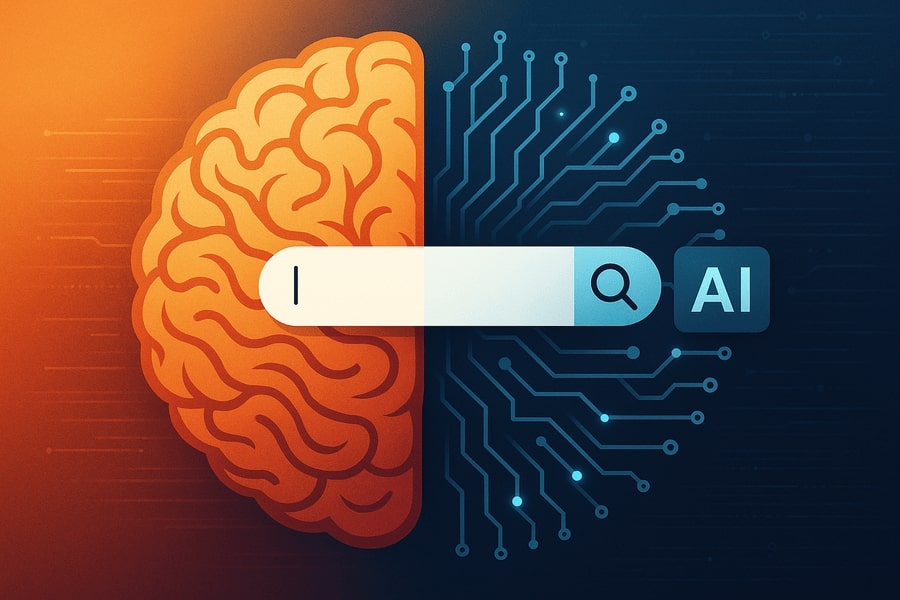Categories
Tags

Search engines may run on code, but people don’t. When someone opens their browser, they’re not looking for keywords—they’re looking for clarity, confidence, and a sense of momentum. They want the right answer, and they want to trust it.
That’s why the best AI SEO strategies aren’t built by technicians. They’re built by people who understand what drives attention, belief, and decision-making. They’re built by psychologists.
Contents
The Illusion of a Technical Discipline
AI SEO is often framed as a technical field dominated by code, crawl budgets, and metadata. But if you ask what really drives clicks, trust, and conversions, the answer isn’t found in the markup. It’s found in the mind.
At Xponent21, we approach AI SEO through a behavioral lens. We ask: What’s the user thinking at this moment? What emotion is guiding their query? What makes them feel confident enough to act?
That approach is rooted in psychology—and it works. In my graduate research in behavioral neuroscience at Yale, I used the marginal value theorem to understand when animals (and people) decide to leave one information source for another. Today’s internet searchers behave the same way: evaluating whether to click, stay, or return to the search engine results page (SERP) based on cues like relevance, clarity, and ease.

Ranking in search results isn’t about manipulating an algorithm. It’s about guiding a human through uncertainty—with empathy, credibility, and careful timing.
Search Isn’t a Query—It’s a Cognitive Shortcut
People don’t want to “search.” They want to know. Every search query is an expression of uncertainty, whether it takes the form of curiosity, confusion, pressure, or doubt.
Your content has one job: reduce that uncertainty quickly, without introducing more complexity.
Here’s what drives that behavior:
- Cognitive Load: Effort feels expensive. If your content is hard to skim or makes people think too much, they bounce.
- Information Foraging: Users, like social foragers, track cues that signal informational value. This includes headlines, formatting, phrasing, and the perceived credibility of the site.
- Cognitive Fluency: Information that’s easy to process feels more true. When your structure, visuals, and tone promote ease, trust follows.
In essence, users are constantly gauging: Is this page worth the mental effort?
You’re not just writing for keywords. You’re writing for neural shortcuts.
The Buyer’s Psychological Journey
AI SEO isn’t about optimizing pages in isolation—it’s about meeting people across the arc of their decision-making journey:
- Awareness – “What is this? Why does it matter?”
- Investigation – “What causes it? Can I fix it?”
- Comparison – “Who does this well? Can I trust them?”
- Commitment – “Is this the one for me?”
What connects each stage is friction—and opportunity. When your content is designed to help users progress seamlessly from one question to the next, they stay with you.
That’s where the Zeigarnik effect comes into play: people remember unfinished cognitive tasks. If you give a satisfying answer but don’t help them take the next step, the loop remains open—but may lead elsewhere. On the other hand, showing related content at just the right time turns your site into a trusted guide. You move users from exploration to exploitation—a concept drawn from social foraging research, where individuals decide whether to seek new information sources or continue relying on a known one. (Turrin et al., 2017).
Your job? Anticipate valuable questions and make sure you’re the source users keep choosing to “exploit.”
Designing for Decision Confidence
When users land on your site, they’re not just looking for information. They’re looking for a signal—that they’re in the right place, that this brand gets them, that they can finally stop searching.
Great content builds that signal in subtle ways:
- Anticipate objections. Don’t make them dig for answers—they won’t.
- Repeat key points in different formats. Familiarity breeds trust.
- Match the user’s mental model. If they expect to see testimonials or pricing, don’t hide those details under clever navigation.
This is System 1 thinking at work—the fast, intuitive process that governs most online behavior. The more frictionless and familiar the experience, the more the user trusts it.
AI Overview as a Social Learning Tool
Today’s search doesn’t always begin with your site—it often begins with an AI-generated summary of what the internet thinks is true.
To the user, it feels like polling the room. A quick, confident answer. Done.
Psychologically, this is a form of vicarious reinforcement learning. Research I co-authored explored how people learn from observing others’ outcomes, not just their own (Joiner et al., 2017). The same brain regions used for personal feedback light up when evaluating what happens to someone else.
AI Overviews offer a similar shortcut. The model has “seen” the top sources. It has aggregated the consensus. And now it’s presenting it back in a digestible form. To the user, this feels like a trusted assistant or social reference group.
If your brand appears there, you gain instant borrowed credibility—not because the user has vetted you, but because the model has. That’s the new front line of trust.
The Role of Emotion in Trust and Conversion
While logic supports decisions, emotion drives them.
People convert when they feel understood, empowered, or inspired—not just when they’re convinced. Great content should reflect emotional cues like:
- Relief from anxiety or overwhelm
- Confidence in their choice
- Hope for a better outcome
- A sense of belonging or alignment
One powerful tool here is narrative transportation—pulling readers into a story that mirrors their own. Whether it’s a testimonial, a scenario-based FAQ, or a day-in-the-life blog post, stories make decisions feel lived—not just logical.
Be the Trusted Source at Every Step
AI SEO isn’t about dominating a single keyword. It’s about building a continuum of confidence. You want to be the name that shows up at every meaningful turn in the journey—whether in the AI Overview, an organic result, a YouTube video, a podcast, or the FAQ.
Over time, your consistent presence builds two critical psychological assets:
- Brand salience – “I keep seeing them.”
- Psychological safety – “I feel good about this.”
By the time a user is ready to act, they already trust you. The only questions left are logistical.
When users feel seen, they stay. When they feel certain, they act.
Psychology Is the Advantage
AI SEO isn’t just a technical discipline—it’s a human one. The best strategies don’t trick the algorithm. They guide the user.
When you design content that reflects how people think, feel, and decide—especially under uncertainty—you create more than clicks. You create confidence. And confidence is what converts.

